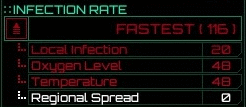Overview
Infection refers to how many mutants inhabit an area. There are three different types of infection that are listed in the game: Infection Rate, Infection Level, and Global Infection. Here is how to understand them.Versioin 1.0
Global Infection
This is listed as a percentage. It is calculated from the Infection Level of each station sector, and thus serves as an estimate of how infected the colony as a whole is. It can basically tell the player how difficult the game is at a quick glance, because a higher number means stronger and more numerous enemies. The higher the number, the more tinted orange the number and the percentage bar will be. In addition, once the global infection is 25% or higher, then a number of mutants may attack Central Control directly in a mutant invasion.

Infection Level
This is listed as a percentage. It tells the player how infected a specific location is. It works just like the global infection, except it is just one location instead of all of the locations in the game. The higher the number, the more difficult an area will be to clear out; there will be stronger and more numerous enemies in an area as the number increases. The higher the number, the more tinted orange the number and the percentage bar will be.

Infection Rate
Infection rate is how quickly the Infection Level is increasing in an area. There are 4 subcategories that affect infection rate: Local Infection, Oxygen Level, Temperature, and Regional Spread. The first thing that is displayed is the speed of the infection with text telling how fast the infection rate is, and a number in parenthesis; the higher that number in parenthesis is, the faster the infection rate in an area.
Local infection is fixed at 20 for every area except Central Control. This number never changes, and therefore makes it impossible to decrease an area’s infection rate to 0. However, once the Purification Data is obtained, an area can be cleansed through the purifying filters that can be produced.
Oxygen level refers to how high the oxygen level is in an area: the lower the number, the lower the infection rate. To increase the oxygen level in an area, place a Oxygen Filter in an area. The higher tier that the Oxygen Filter is, the more it will decrease the Oxygen Level number, which will decrease the Infection Rate more.
Temperature refers to how high the temperature is in an area: the lower the number, the lower the infection rate. To increase the temperature in an area, place a Thermal Regulator in an area. The higher tier that the Thermal Regulator is, the more it will decrease the Temperature number, which will decrease the Infection Rate more.
Regional spread is caused by a nearby location carrying an extremely high infection. A location typically begins spreading out slowly at about 80% infection, and gradually increases in its influence as the infection increases. All locations within another location’s regional spread gain 5 Regional Spread, and this can accumulate if more than one nearby location is sufficiently infected. Central Control is unaffected by regional spread.

Fighting the infection
- The easiest way to decrease the infection level and infection rate in an area is to kill all the mutants you see and to place Oxygen Filters and Thermal Regulators in an area. However, this is both time-consuming and resource intensive.
- Maintaining a low infection level in the core sectors is both easy and useful for deterring mutant invasions from those particular sectors.
- Once an area has Oxygen Filters and Thermal Regulators in it, it will decrease the infection rate, but it will still increase steadily, so keep an eye on it.


